Anvil of Stars tfog-2 Read online
Page 2
Inside the locker, smaller bubbles of gray spotted the pale gray and brown walls like sporangia on fern leaves. The comparison was apt; these held millions of tiny robots, makers and doers, some the size of microbes, some a meter wide, most no larger than a human fingernail. Makers could burrow deep into a moon or planetary surface and create weapons of mass destruction out of the raw materials available. Doers could insinuate themselves into many kinds of machinery and break them down.
At the end of pylons or snared in pale fields hung matte gray tubes three meters thick and ten to twenty meters long. Gray ovoids, saucers and sausage-packed spiked cylinders five to twenty- five meters across were stacked double and triple, gripped by fields wrapped around pylons.
Entering the locker, Martin always felt as if he had walked into a sculpture hall dedicated to geometric abstractions, or onto a microscope slide of plankton and bacteria magnified huge. The style—if one could think of a style with regard to such simple shapes—was the same as the style Martin had come to associate with the moms, the Central Ark, and the general design of the Dawn Treader: utilitarian, muted basic colors, a subdued raw metal appearance for all surfaces.
Martin counted the piloted weapons stored here: not including those hidden in the blisters, there were ninety separate pieces.
“Let’s study,” Stephanie said, swinging down from the middle of the ranked weapons. They gathered at their craft.
The bombships and rifles opened their sides with soft hisses. The children deftly kicked themselves into the cockpits. Ladders vanished once the hatches smoothed shut. Martin entered his rifle last, feeling the soft interior conform to his shape.
“This craft belongs to Martin Spruce,” the rifle told him. The children knew the voice of the moms, warmly impersonal, craft voices cool and technical, and ship’s voice, rarely heard, soft and pleasant, not quite feminine. Martin believed they were actually all the same, but that was one of the questions not answered.
“All wands slaved to your wand, simulation drill,” the craft voice told him. “May we draw the simulation plan from your wand?”
“Yes,” Martin said.
The simulation began. The craft did not move from their docked positions. The children became enmeshed in the drill, and time passed.
They skimmed the cloud tops of a gas giant planet three times larger than Jupiter, while the Ship of the Law grazed the atmosphere ahead of them, wrapped in plasma friction fire. The Dawn Treader’s wing-like scooping fields dragged huge gouts of atmospheric hydrogen and methane and ammonia from the thick atmosphere, slowing the ship at dozens of g’s, torquing it tail over nose, and the smaller weapons sped ahead of the ship, encountering enemy craft, setting up a circuit of protection, drawing the attention of kinetic weapons designed to smash into them at high speed, using the roiling energies of the fireball created by the Dawn Treader’s passage to deflect energy beams…
As usual, they did well.
They had done well at this sort of drill for years now. It was second nature to them. It had also become a kind of game, difficult to connect to reality, to the actual performance of the Job itself. However convincing the simulations—and they were very convincing—they no longer expanded the children’s skills.
Still, they drilled tenday after tenday, year after year…
Growing older. Martin could feel their impatience, and it worried him.
He was responsible. He had been Pan for six months.
Martin laddered deep past the pipes and conduits in the long first neck of the Ship of the Law, going to the forward homeball and the schoolroom to meet with a mom and report for the tenday. Aboard the Dawn Treader there were twenty-eight hours to each day, three tendays in a month, twelve months in a year. Once each tenday, it was Martin’s duty as Pan to report to the mom. To tell what the children had been up to, and listen if the mom had anything to say.
He completed his climb through the neck, into the homeball and down a long cylindrical corridor to the homeball’s center. His ladder field stopped at a wide hatch; he kicked away and grabbed a metal pole within, swinging gracefully until the friction of his hand stopped him.
The schoolroom periphery was cool and dark. Light from the corridor cut at an angle and made a spot on the opposite curved wall.
Martin had arrived fifteen minutes early. He was alone.
Under weightless conditions, the schoolroom took a shape like the empty interiors of two wheels run through each other, sharing a common center, axes perpendicular. Twenty meters below, at the hub of the schoolroom, the homeball’s center, hung a spherical blackness filled with stars, a window to what lay outside the ship—but not directly viewed; like so much else in their life, a simulation.
At the ship’s present speed, the universe outside the Dawn Treader did not much resemble this pretty simulation. Outside the true stars were gnarled and twisted, rotated and compressed into a scintillating ring that flexed around the ship like a loose bracelet, blue on one side—the direction in which they flew—and red on the other, with a muddy and narrow mix of colors between. Ahead lay a pit empty to the unaided eye but in fact filled with hard radiation; behind, another pit, touched with weird sparkles of red-shifted X-ray sources, distant galaxies dying or being reshaped, dead stars ghoulishly eating their young.
The starry sky in the sphere appeared little different than it had on Earth, unless Martin looked for familiar constellations. None were visible; the Dawn Treader had traveled too far. Associations of the brightest stars had changed radically.
He took his wand from a pocket and let it hang in the air, floating beside him in the warm twilight. Martin and the wand precessed slowly, blown by idle air currents. Martin reached out with a finger and wrote two names large in the air: Theresa, William. The names glowed pink and electric blue, respectively.
Under Theresa, Martin used his index finger to write I’ve lived with or near you for five years, but only in the past tenday have I known what I feel for you. What you feel for me. Odd how we haven’t come together until now! I think of you always. I miss you when I am not near, even just a few minutes away. It’s not just physical wanting, though there is that, and it is almighty powerful, but a kinship, a matching like two molecules meeting in just the right way, and that is strange, because that is how I have often thought of God. I hope you don’t think this is all too intense; but perhaps it is through you, our love, that I really feel God. Don’t be afraid. I haven’t lost it. But can you tell me why we have not felt this before, have not known it until now? So fast!
The glowing message beneath Theresa shimmered slightly: the wand querying whether he wished to continue or quit and send. He lifted his finger again and wrote more:
I’ve told William, and he approves, or at least he does not tell me he objects. I know that you do not detract from our friendship, though I feel less free with him now, but he knows or intuits what there is between us, you and me, and that makes him wiser than I. He is a noble spirit. I realize your reluctance to break up a dyad that seems so stable, but you cannot take away from us what is most important. William and I are brothers, as I never had a brother. You cannot break that, and you cannot replace it.
I send you this, because I miss you even when I am on duty, and there is a short time here before I report to the mom.
I feel so naive but my love for you is more intense than any positive emotion I have felt until now, and I want you to know that.
He read the message through several times and winced at its awkwardness, its revelation. Even among the children Martin was reluctant to open himself so. He felt like a boy again, though at twenty-two he was one of the oldest on the Dawn Treader. Theresa was three years younger; William, a year younger.
“Send,” he said, and the message and Theresa’s name vanished, leaving William hanging alone. The name flickered. “I’m thinking,” Martin told the wand. Could he really remain involved with William, when he focused so much attention on Theresa?
Irony here. Throu
ghout the voyage he had tried to keep above the play of emotions, to maintain his dignity, finally joining in a dyad with William because he could not resist the pressure to make some tie, and William seemed safest, and they did match.
Because of his aloofness, Martin had gained both respect and isolation; he had been voted sixth Pan of the Watch, an important position, and then (it seemed inevitable now, understanding the venery associated with position “and power) the Wendys had courted him, and he had dallied; that was expected. William did not object, in fact fantasized of what he would do when he became Pan.
Martin had lost his shield; and flirting with Theresa—initially innocent sex—had plunged him deep into what he had avoided for so long. It had to happen.
Still in him lingered fear of loving and losing, not just through separation, but through death. All of them had known the same losses—Earth itself, great Mother of all they knew and were; then separation from family and friends on the Ark.
They were more than children sent on a time-bent crusade; they were avenging angels, soldiers trained but not yet tested, given access to incredible power they did not completely understand. Eventually they would use that power if they were to fulfill their mission, and some of them would not survive.
As for William, Martin had nothing to say to him that he could not say better in person. “Fade,” he instructed. The name vanished. He raised his arms and crooked a finger and a thin ladder of green light crossed the periphery. He pointed his finger and the light flowed, broke up, and reformed, spanning one wheel of the schoolroom and intersecting the star sphere.
Martin poked his hands and feet into the plane and pushed himself ahead, drifted lazily around the sphere, viewing the stars from many angles. Folded his arms and drew up his long, thin legs to wait for the mom.
Martin had inherited his father’s physique and his father’s long, grim face; he also had his father’s sweetness of temper and sharpness of mind. But his almond eyes and his sensuous, full lips over protruding front teeth were his mother’s.
A mom entered from below and moved up silently beside him, a squat flattened cylinder about a meter tall, copper and tarnished brass, with a head-like bump but no features, no arms, and no legs.
“I am ready for your report,” the mom said. The mom’s voice was authoritative but not shrill or insistent. It never demanded, never ordered, merely instructed and guided. A mom always referred to itself in the first person, as did the ship’s mind on the rare occasions it was heard from. The children had no evidence, other than tone of voice, that ship and moms were any different.
“We’re doing okay,” Martin said. “The children all seem healthy, physically.” He looked away. “There’s some tension with four or five individuals who aren’t getting along with the rest. Rex Live Oak has troubles now and then. A few others. I’m keeping track and trying to work them back into the group. Rosa Sequoia’s the worst. She attends the meetings, does her drills, hangs around when we play games, but she has few friends now. She doesn’t even talk with the Wendys much.
“Exercises are going well. We’ve been simulating small-craft navigation in planetary space, orbits and evasive maneuvers, ship’s defense, shepherding makers and doers. I guess you know that.”
“Yes,” the mom said.
His neck grew stiff. Here it came. “I’d like to see some outside exercise. The real thing. I think we’re ready.”
This was the third time he had made such a suggestion in his six months as Pan. All the children were anxious to get outside the Dawn Treader in the craft they had been training to use. “Five and a half years is a long time. We’ve come a long way. We know it might take much longer, but… We’re impatient.”
“Understood,” the mom said. “Continue.”
“I suppose we’re growing up, more mature. There’s less upset… not as much squabbling about sexual stuff. Fewer arguments and noise. I talked about this last tenday.”
“These are all expected events.”
“Well, they’re still significant,” Martin said, irritated by the mom’s attitude, or non-attitude. “I’m trying to use this… calmness, whatever, to help us focus on the training. It’s working, a little, anyway. We’re doing better in the trials. But there’s still grumbling about how well informed we are. I’d like to suggest fuller participation. I’ve suggested that before.”
“Yes,” the mom said.
“That’s about it. Nothing spectacular.”
“I see no signs of major trouble. You are doing well.”
With a characteristic lack of the minutiae of social grace, the mom glided from the schoolroom along its own unseen ladder field.
Martin puffed his cheeks, blew out a breath, and turned to leave, then spotted Hakim Hadj in the doorway below.
Hakim moved aside for the mom’s passage and spread his ladder to where Martin waited by the star sphere.
“Hello, Pan Martin,” Hakim said. He climbed to within a couple of meters of Martin and assumed a floating lotus. “How are you today?”
“As usual,” Martin said. He bit his lower lip and gestured at the door with an unenthused hand. “The usual friendly brick wall.”
“Ah yes.” Leader of the search team, Hakim was shorter than Martin by seven or eight centimeters, with smooth brown skin, a thin sharp nose, and large confident eyes black as onyx. He spoke English with a strong hint of Oxford, where his father had gone to school.
To see Hakim blink was a wonder; his face conveyed centuries of equanimity in the midst of strife, his lips composed a genial and unjudging line. “I am glad to hear it.”
He had taught Martin Arabic a few years before, enough for him to read Arabic children’s books from the libraries, but the lingua franca of the Dawn Treader was English, as it had been aboard the Central Ark, Earth’s death having frozen the American moment in history.
“The search team may have a suspect,” Hakim said. “I would like to present the evidence to you, and then to the moms. If you do not agree, we will keep our thoughts from the moms until better evidence comes along.” Hakim was usually cautious and taciturn to a fault about the search team’s work.
Martin arranged himself in a less graceful lotus before him. “I just gave my tenday report…”
Hakim apologized. “We cannot be certain enough to render final judgment—but there is sufficient evidence that we believe the ship should send out remotes…” He caught himself, apologized again, and said, “But that is your decision, Martin.”
Martin said, “No offense taken, Hakim.”
“I am glad. We have found a stellar group of three stars less than a light-year from our present position. The spectra of the two contain a mix of trace radioactive elements and rare earths in proportions similar to those in the remains of the captured killer machines.”
Hakim presented the facts for Martin with his wand; they appeared to float before him, or he among them, words and images and icons and charts, a visual language created by the moms. Martin had become used to this method of teaching on the Ark; now he took it in stride.
At the center of the displays hung diagrams of three stellar systems. Figures surrounding the diagrams told him that these stars were no more than a trillion kilometers from each other.
The moms used stellar classifications based on mass, diameter, luminosity, age, and percentages of “metals,” elements heavier than hydrogen and helium. Martin was more used to this scale than the one that would have been familiar to his father. The children had converted some of the moms’ technical terms to more informal language: Thus, the closest star was a Buttercup Seven, about nine tenths the mass and diameter of Sol, bright yellow, relatively high in metals. The second closest was a Cornflower Two, one and a half times Sol’s mass, with a lower percentage of metals. The third star in the group was an aging Firestorm Three, a brilliant bloated red giant. The Buttercup Seven had four planets, two of them peculiar, diminished gas giants.
Hakim noticed his interest in these worlds. “
They are substantially smaller than might be expected—evidence of gas mining, perhaps,” he said.
Martin frowned. Tough to refuel the Ship of the Law in a system that had already been tapped out by an old civilization.
Two rocky planets hugged close to the Buttercup Seven. In addition, there were several—perhaps as many as five—invisible bodies close to the star. Together, they might have added up to the mass of Earth’s moon.
The Cornflower Two, a pale yellow giant, had ten planets, two of them apparent gas giants. The Firestorm Three was surrounded only by small rubble; at some ninety million kilometers in diameter, it could have swallowed several planets when it ballooned.
Numbers flickered in and out of his awareness; his eyes shifted around the display, picking out what he needed to know.
Martin examined the intrinsic spectra of the stars. There were intriguing diffraction patterns, unnatural ratios of infra-red versus other frequencies. A technological civilization had been at work around at least two of the stars, the Buttercup and the Cornflower.
“How long ago did the Firestorm balloon?” he asked.
“We estimate five thousand years,” Hakim said.
“Did they armor?”
“The civilization around the Buttercup apparently armored. We have no direct evidence yet for the Cornflower.”
“But they haven’t built an all-absorbing envelope…”
“No,” Hakim agreed. An envelope around each star—a Dyson construct of multiple orbiting structures surrounding the star in many layers—would have reduced the stellar images to heat-waste, dull infra-red only. Martin checked the information available on the interstellar particle fluxes surrounding the stars—the stellar winds—and felt a tickle of apprehension.
The Ship of the Law was one point eight trillion kilometers from the nearest, the Buttercup. Martin reached out to touch a glowing geometric shape pulsing slowly next to the star images. The shape unfolded like a flower into a series of pentagonal petals. He touched the petals in sequence until he had the information he desired. “The Buttercup may have large structures in orbit, besides these five dark masses. You think that’s sign of armoring?”

 Foundation and Chaos
Foundation and Chaos Halo: Silentium
Halo: Silentium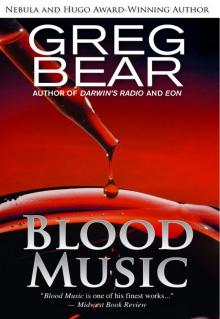 Blood Music
Blood Music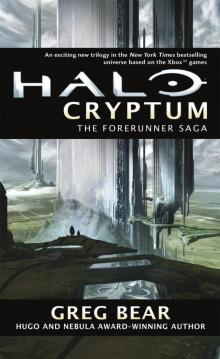 Halo: Cryptum
Halo: Cryptum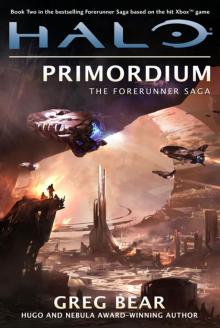 Halo: Primordium
Halo: Primordium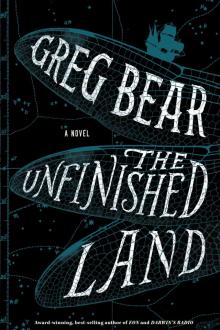 The Unfinished Land
The Unfinished Land Hardfought
Hardfought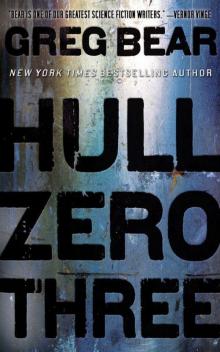 Hull Zero Three
Hull Zero Three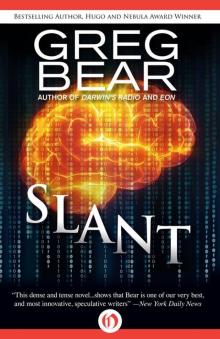 Slant
Slant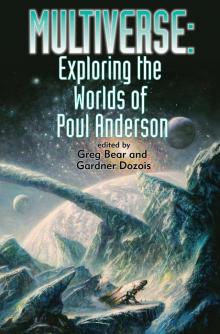 Multiverse: Exploring the Worlds of Poul Anderson
Multiverse: Exploring the Worlds of Poul Anderson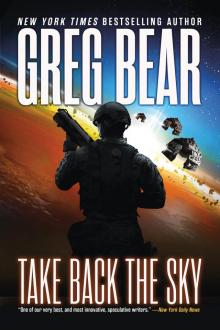 Take Back the Sky
Take Back the Sky Nebula Awards Showcase 2015
Nebula Awards Showcase 2015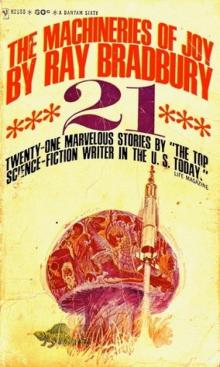 Machineries Of Joy
Machineries Of Joy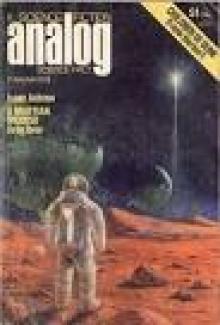 A Martian Ricorso
A Martian Ricorso Eternity
Eternity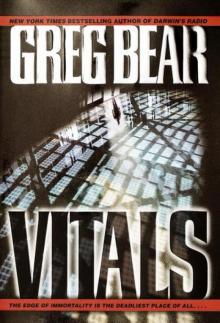 Vitals
Vitals The Infinity Concerto
The Infinity Concerto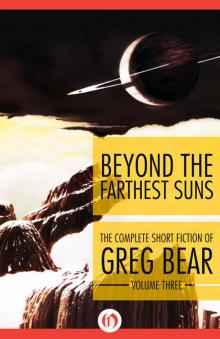 Beyond the Farthest Suns
Beyond the Farthest Suns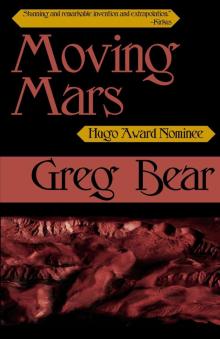 Moving Mars
Moving Mars Quantico
Quantico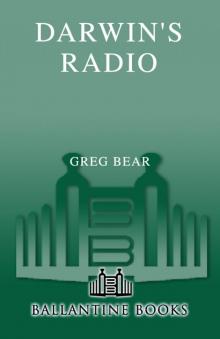 Darwin's Radio
Darwin's Radio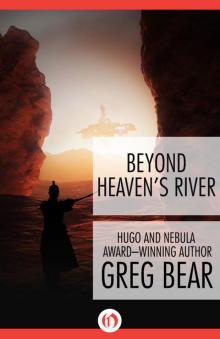 Beyond Heaven's River
Beyond Heaven's River Star Wars - Rogue Planet
Star Wars - Rogue Planet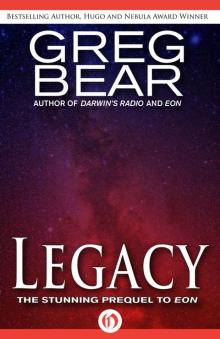 Legacy (Eon, 1)
Legacy (Eon, 1)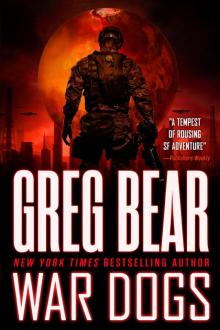 War Dogs: Ares Rising
War Dogs: Ares Rising Sisters
Sisters Dead Lines
Dead Lines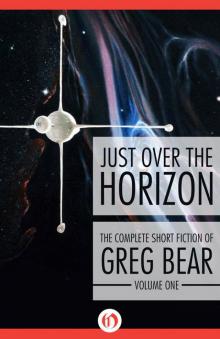 Just Over the Horizon (The Complete Short Fiction of Greg Bear Book 1)
Just Over the Horizon (The Complete Short Fiction of Greg Bear Book 1)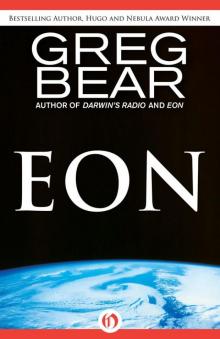 Eon (Eon, 2)
Eon (Eon, 2) Venging
Venging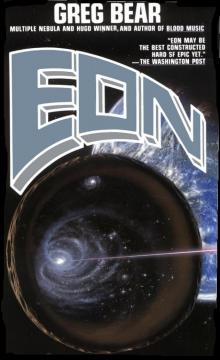 Eon
Eon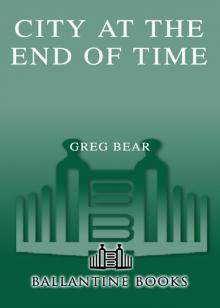 City at the End of Time
City at the End of Time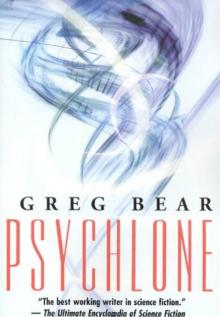 Psychlone
Psychlone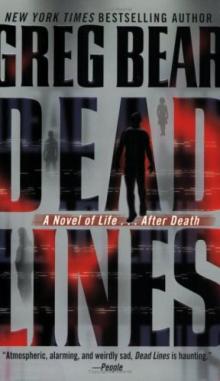 Dead Lines, A Novel of Life... After Death
Dead Lines, A Novel of Life... After Death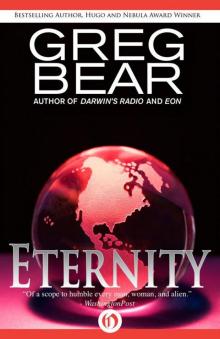 Eternity (Eon, 3)
Eternity (Eon, 3)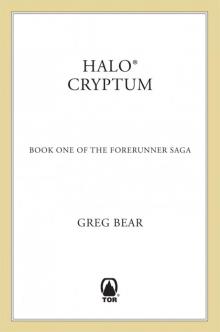 Cryptum
Cryptum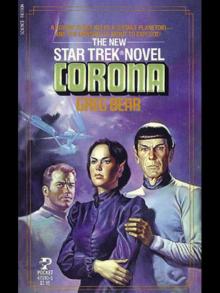 Corona
Corona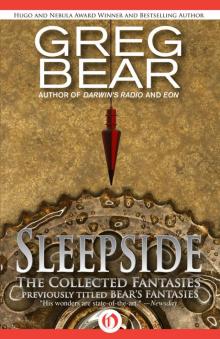 Sleepside: The Collected Fantasies
Sleepside: The Collected Fantasies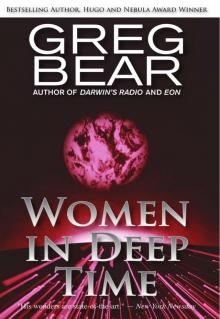 Women in Deep Time
Women in Deep Time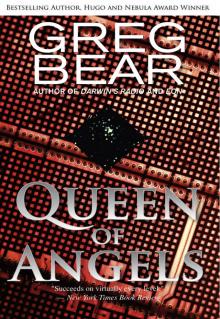 Queen of Angels
Queen of Angels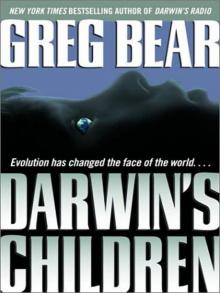 Darwin's Children
Darwin's Children Dinosaur Summer
Dinosaur Summer The Forge of God tfog-1
The Forge of God tfog-1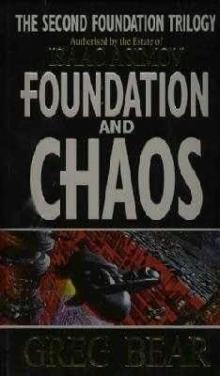 Foundation and Chaos f-9
Foundation and Chaos f-9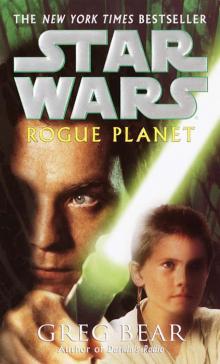 Star Wars: Rogue Planet
Star Wars: Rogue Planet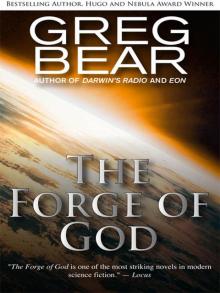 The Forge of God
The Forge of God Mariposa
Mariposa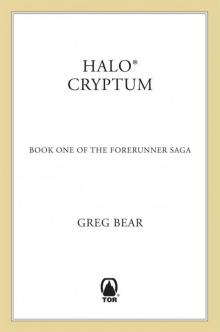 Halo: Cryptum: Book One of the Forerunner Saga
Halo: Cryptum: Book One of the Forerunner Saga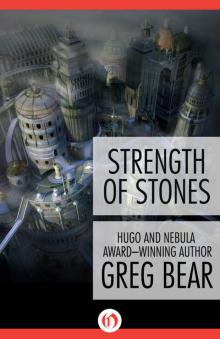 Strength of Stones
Strength of Stones Anvil of Stars
Anvil of Stars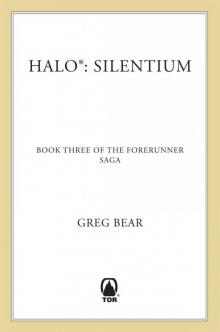 B00AQUQDQO EBOK
B00AQUQDQO EBOK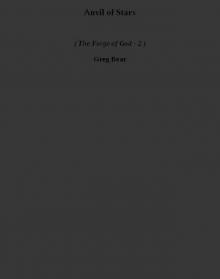 Anvil of Stars tfog-2
Anvil of Stars tfog-2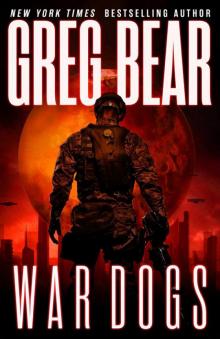 Ares Rising 1: War Dogs
Ares Rising 1: War Dogs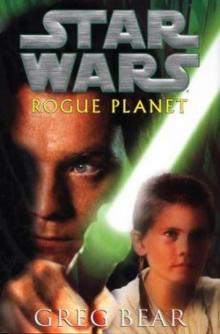 Rogue Planet (star wars)
Rogue Planet (star wars) The Machineries of Joy
The Machineries of Joy Far Thoughts and Pale Gods
Far Thoughts and Pale Gods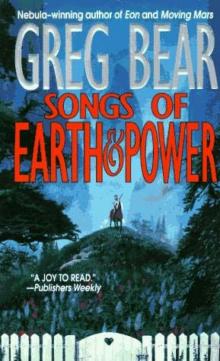 Songs of Earth and Power Omnibus
Songs of Earth and Power Omnibus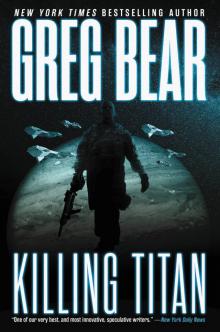 Killing Titan
Killing Titan Darwin's Radio d-1
Darwin's Radio d-1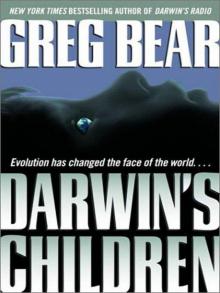 Darwin's Children d-2
Darwin's Children d-2